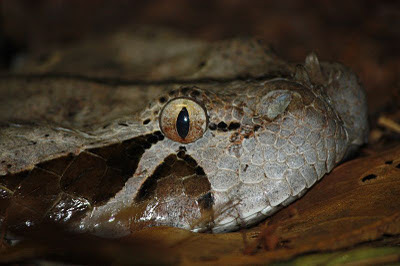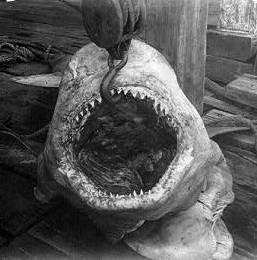A Keeper's Tale, Part 1 of 5: Sharks

by guest writer Hodari Nundu
I am kind of an artist. I've been drawing since I was threeyears old. That's also about the time I became obsessed with dinosaurs and allsorts of wildlife both living and extinct. Most of my drawings depicteddinosaurs, rattlesnakes with impossibly long rattles, and sharks, along withcomically square cars with oversized radio antennae. Today, I believe I ampretty good at drawing dinosaurs, rattlesnakes and sharks- my cars still lookthe same, though.
I have a job as a cartoonist in a newspaper and I draw a lotwhen I have free time. Also, I write- both fiction and non-fiction. In otherwords, I use my fingers quite a lot. This is the reason why, despite wishing tobecome a zookeeper since age 15, I always hesitated a bit.
Anyone who has read anything about wild animals in captivityknows that being a zookeeper is no joke. All young boys and girls who dream ofbeing zookeepers or animal trainers seem to operate under the impression thatthey will magically develop a close bond or relationship with their animalcharges, and that it will be awesome to have a ferocious tiger or gigantickiller whale following your commands and being as loving and obedient as apuppy as the crowd watches in awe.
But I always knew reality was nothing like that. I knew that zookeepers had adangerous job. They were often mauled, envenomated, trampled, even crippled orkilled. Although wild animals are indeed capable of bonding with their keepers,provided they are treated with respect and that their needs are fulfilled as muchas possible, that doesn´t mean they become puppies. A leopard cannot change itsspots. And leopards have been eating humans since prehistory. Even years oftraining can´t beat millions of years of predatory instincts.
What worried me the most, as a teenager trying to figure outwhat he wanted to do in the future, was not the (very real) danger of beingmauled to death by a zoo animal. I wasn´t very afraid of death at the time. Iwas more worried about my fingers. I had been told that one of the most commoninjuries zookeepers suffered was the amputation of fingers. Either directly,due to the bite of an animal (and a surprising number of finger-choppers werenot even predatory), or indirectly, as a desperate measure to save someone fromdying a painful death. A friend of my father's had worked at the local zoo. Hetoo was an artist- he painted the jungle-mimicking backgrounds to the snakeenclosures in the reptile house. He told us that an unfortunate snake-keeperhad been bitten in a hand by a Gaboon viper- one of the deadliest snakes in theworld, and the record-holder when it comes to the longest fangs of any snake.
 Gaboon Viper (Ltshears/Creative Commons)
Gaboon Viper (Ltshears/Creative Commons)There was no antivenom available at the time, and so theyhad to chop the man's hand with an axe to prevent the venom from spreading to hisbody. He lived, but his story was scary enough for me to think twice about mywild dream. After all, as much as I loved animals, I loved drawing and writingjust as much, and I needed my hands and fingers intact to do that.
For a little while, I forgot about the zookeeping dream.Then, one day, the local zoo made anannouncement. The exhibit formerly known as the Nocturnarium was to be closedpermanently, and all the animals in it- which had been caught in a nearbynatural preserve- were to be released back into the wild, except,unfortunately, for the vampire bats, since the risk of having them infect thewild ones with a disease was too high (it had to do with the vampire habit ofregurgitating blood meals into the mouths of hungry mates).
The good news was, the Nocturnarium building would beadapted into an Aquarium. And there were going to be sharks.

Now, sharks are among my favorite animals. When I was a kid,a group of friends and I found a requiem shark's severed head in a beach. Somebelieved that the shark had been beheaded with a machete, perhaps by afisherman. However, it made little sense to me, as I figured a fisherman whotakes the time to hack a shark's head off would probably keep the head insteadof throwing it away. Besides, it didn´t look like it had been cut off with a machete.In fact, the head bore every sign of having been bitten off by another, biggershark. I asked a local diving guide if there were any large sharks around. Hesaid the biggest he had seen were about four meters long.
However, my favorite encounter with a shark, although notvery close, was when my family and I went on a brief tour in Puerto Vallarta onboard of a small yatch. The yatch was taking us to a small island nearby (which,as we eventually learned, was teeming with leeches). It was the journey to theisland that was interesting. I saw hundreds of bright blue Man'O'War andjellyfish, and a pod of bottlenose and spotted dolphins swam besides the yatchfor a while.
Also, we saw a shark. I couldn´t tell what species it was.All I know is that it was too busy feeding on a huge fish shoal to pay us anyattention. But even the brief glimpses of its dark, triangular dorsal fin wereenough to hypnotize me. I had seen a shark, alive, in its natural habitat. Myfascination with these animals was even greater since that day.
So of course, as soon as the sharks arrived to thenewly-inaugurated Aquarium, I went to visit. Once again, I was captivated bytheir beauty, their elegance, the way they glided through the watereffortlessly, almost as if they were ingravid creatures from another dimension.I spent over two hours standing in front of the tank, ignoring the noisychildren around me, and the desperate guard who kept telling people, to noavail, that it was forbidden to touch or hit the glass. After a while, Idecided that I wanted to be a shark keeper. I knew it was dangerous and Isuspected that no self-respecting zoo would allow an unexperienced boy to dealwith such umpredictable animals without previous training. But I still wantedto try my luck. I went looking for the Aquarium managers and asked them manyquestions about the sharks. I was told that all of the Aquarium's sandbarsharks were females (although I had already deduced this by looking at their pelvicfins), and that they all had names. The names were all rather comical- it is apart of Mexican culture to make a joke out of everything. Unfortunately, I haveforgotten the names. They also told me that the keepers only went into the tankwhen it was absolutely necessary.
When I asked them if I could apply to be a shark keeper,they told me just what I expected. I needed previous experience working withanimals. The zoo was very strict about who got to work with the creatures. Onlyvets and veteran biologists had that privilege. Of course, they said, I couldalways apply for a more normal job at the zoo- a cleaner, for example.
Needless to say, I didn´t even consider it. Not because Ithink being a cleaner is demeaning-- but because what I wanted was to be in thewater with the sharks, to look at their eyes and touch them and feed them,hopefully with some other creature's flesh instead of mine.
I was a little bit disappointed but at the same time, I wasrelieved. My hands weren´t in danger of being bitten off for the time being.
I still dream of swimming with wild sharks, or going on oneof those cage-diving trips to Isla Guadalupe, an island in the Gulf ofCalifornia which is known as one of the best spots to see great white sharks upclose. To date, none of my friends or relatives understand why I would want togo into the water with a two-ton predator known to bite human limbs off as ifthey were made of butter.
I really don´t know the answer, to be honest. Maybe I'm justan adrenaline junkie. Maybe I'm just madly in love. I am terrified of death,but there is one thing that terrifies me even more; the idea that the greatwhite shark may go extinct before I get to look directly into its dark blueeyes. Somehow, I feel I will not becomplete until I do.
Next: Part 2: Iguana-Infested Woods
Published on November 22, 2011 09:00
No comments have been added yet.



